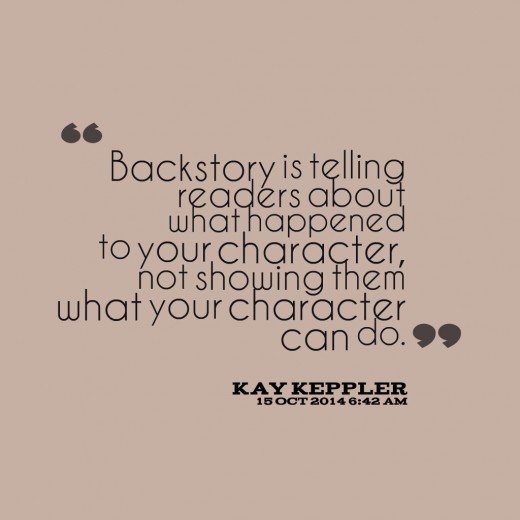The Stages of A Story by Kay Keppler
 Let’s welcome back monthly columnist, editor and novelist Kay Keppler, as she shares with us about “The Stages of A Story.” Enjoy!
Let’s welcome back monthly columnist, editor and novelist Kay Keppler, as she shares with us about “The Stages of A Story.” Enjoy!
***
Structuring genre novels and Hollywood movies is simple. (It’s the writing that’s hard!) They’re built on only three basic elements—character, desire, and conflict—and have a plot structure that consists of six basic stages. These stages help you build tension and conflict into your story and strengthen its emotional impact. In a well-structured story, the stages and their five turning points occupy, relatively speaking, the same positions in the narrative.
Here’s how it works.
STAGE I: The Setup
In film, the storyteller takes a little time (perhaps 10%) to engage the audience and reveal the hero’s everyday life. Most contemporary genre fiction plunges into the crisis almost immediately, providing the hook and the drama that keeps readers turning pages.
TURNING POINT #1: The Opportunity
Very soon into a screenplay, the heroine must have an opportunity that creates a new desire and starts her on her journey. In The Wizard of Oz, Dorothy meets the charlatan magic man. In Agnes and the Hitman by Jennifer Crusie and Bob Mayer, Agnes is on the phone with her uncle, telling him why her fiancé isn’t so bad when a kid with a gun walks into her kitchen.
STAGE 2: The New Situation
For the next 15% of the story, your heroine reacts to the new situation. She tries to figure out what’s going on or formulates a plan for accomplishing her goal. Usually the protagonist enters this new situation with excitement or believing that the new problem can be easily solved. Dorothy looks into the crystal ball and decides to go home. Agnes hits the kid with the frying pan and asks her uncle what to do.
TURNING POINT #2: The Change of Plan
Something must happen to your protagonist one-fourth of the way through your story that transforms her original desire into a specific, visible goal. In The Wizard of Oz, this is when Dorothy’s house drops from the tornado and kills the Wicked Witch of the East, propelling her into searching for the Wizard, who can tell her how to get back to Kansas. In Agnes and the Hitman, this is when Agnes has a showdown with her cheating fiancé and she determines to make the wedding and catering business a success without him.
STAGE III: Progress
For the next 25% of your story, your protagonist takes action to achieve her goal despite whatever obstacles she faces. Dorothy and the scarecrow are pelted with apples, survive a ball of fire, and get through the field of poppies. Agnes works on delivering the best wedding ever to the high-society matron without her fiance’s help.
TURNING POINT #3: The Point of No Return
At the exact midpoint of your story, your heroine must fully commit to her goal. Up to now, she could go back to the life she had at the beginning of the story. By midpoint, though, that option has expired. In The Wizard of Oz, this time comes when Dorothy and her friends get to the Emerald City and visit the Wizard, who promises to help if they bring back the Wicked Witch’s broomstick. In Agnes and the Hitman, this point comes when Shane, the man who’s been helping Agnes, tells her he’s a hitman.
STAGE IV: Complications and Higher Stakes
For the next 25% of your story, achieving the visible goal is far more difficult, and your heroine has much more to lose if she fails. Dorothy can’t just avoid the Wicked Witch—she has to track her down and get her broomstick. Agnes has to bring off a wedding in a location that’s now a murder scene—and the mafia is coming to town.
TURNING POINT #4: The Major Setback
At the three-quarters mark, something so terrible must happen to your heroine that your reader or audience thinks that all is lost. In The Wizard of Oz, the Wicked Witch captures Dorothy and Toto and threatens to kill them to get the ruby slippers. In Agnes and the Hitman, Agnes is arrested for murder, and Shane is attacked and left for dead.
STAGE V: The Final Push
When all seems lost, your heroine musters all her courage to achieve her goal. Dorothy helps Toto escape to get help, and everyone works together to escape the castle. Agnes rescues the wedding and finds the evidence to get her house back.
TURNING POINT #5: The Climax
At the climax of the story, the heroine faces the biggest obstacle yet, she determines her own fate, and she achieves her goal. Dorothy faces off against the Wicked Witch and douses her with water, destroying her. Agnes fights off her enemy’s knife attack and asks Shane to stay.
STAGE VI: The Aftermath
The end of your story should show that your heroine achieved her goal and reveal her new life. In The Wizard of Oz, Dorothy wakes up from her dream and finds that she’s back in Kansas with her aunt and uncle and all the farm hands. In Agnes and the Hitman, Agnes is home from the hospital, her home and business secured, and Shane in residence.
A Final Note on Structure
Both novels and screenplays follow this basic structure, with a slight difference: In a screenplay, the turning points always occur at exactly the same place, the same percentage of time into the story. What happens 25% of the way into The Wizard of Oz is the same thing that happens 25% of the way into Avatar. However, turning point locations can be more fluid in novels.
Although readers and audiences are accustomed to structures that built on this kind of timeline—and story pacing benefits from rising tension—don’t let these percentages block your creativity. Structure helps you strengthen the emotional impact of your story, but you don’t want to be imprisoned by it. Write characters you love and a story that fires your interest. Then apply these structural principles to ensure that your novel or screenplay touches the widest possible audience.
***
ABOUT THE AUTHOR
Kay Keppler is an author Zero Gravity Outcasts, Betting on Hope, Gargoyle: Three Enchanting Romance Novellas, and editor of fiction and nonfiction –Angel’s Kiss and Outsource It! She lives in northern California. Contact her here at Writer’s Fun Zone in the comments below, or at kaykeppler@yahoo.com to ask questions, suggest topics, or if you prefer, complain.
is an author Zero Gravity Outcasts, Betting on Hope, Gargoyle: Three Enchanting Romance Novellas, and editor of fiction and nonfiction –Angel’s Kiss and Outsource It! She lives in northern California. Contact her here at Writer’s Fun Zone in the comments below, or at kaykeppler@yahoo.com to ask questions, suggest topics, or if you prefer, complain.






